Colorization, Inc.
Revision as of 18:43, 4 November 2020 by Travis (talk | contribs) (Created page with "<div class="WPC-editableContent"><div><font size="3"><font><u>Background</u>: In 1983, Hal Roach Studios patented a process that converted black-and-white programs into co...")
Background: In 1983, Hal Roach Studios patented a process that converted black-and-white programs into color. Colorization, Inc. operated in Toronto, Ontario, Canada and specialized in "colorizing" such programs. The firm was responsible for the first-ever colorization, Helpmates, starring Laurel & Hardy, which spawned more tinting of films with the comedy duo. It also created the first computer-colorized feature film, Topper. Colorization, Inc. also color-converted It's a Wonderful Life, Night of The Living Dead, some Otto Preminger films, and many others. Some of the people who worked there went on to form Legend Films, another colorization company.
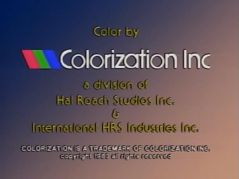
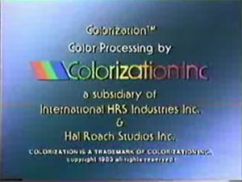
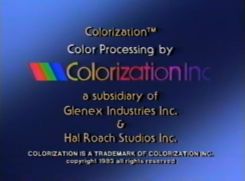
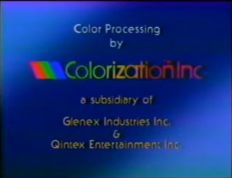
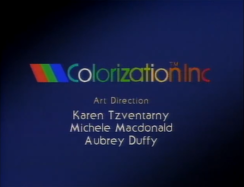
<iframe frameborder="0" height="180" src="http://wikifoundrytools.com/wiki/closinglogos/widget/unknown/0a200803c40df6fe8d068b85051bfe728cc19e6d" width="244"></iframe>
-------------------TM
Colorization
Color Processing by
Colorization
Color Processing by
above the logo, and
a subsidiary of
International HRS Industries Inc./Glenex Industries Inc.
&
Hal Roach Studios Inc./Qintex Entertainment Inc.
International HRS Industries Inc./Glenex Industries Inc.
&
Hal Roach Studios Inc./Qintex Entertainment Inc.
below it, all in the colors you see here (the second line is supposed to be white). Below all that is some white copyright info. All of this fades out, and the text
Colorization Art Director
Brian Holmes csc
Brian Holmes csc
appears.
Variants:
- For TV shows, the animation is slightly sped up, and the following credits
Art Direction
Karen Tzventarny
Michele Macdonald
Aubrey Duffy
Karen Tzventarny
Michele Macdonald
Aubrey Duffy
appear below instead. The background is a navy blue/black gradient here, and a trademark symbol is located on the N in "Colorization".
- A very early version has the logo still and on a cream/navy blue gradient background. Here, the text is chyroned in, with "Colorization Inc" staying white, and the credits are arranged differently.
- Later on, when it gone under Qintex's control, the logo resembles its TV counterpart and has the top line and copyright missing.
FX/SFX: The three color bars meeting, the logo "glowing" in rainbow colors.
Music/Sounds: It begins with three synth horn notes synced to the appearance of the color bars, then a few synth bells, a seven-note synth horn fanfare, four more synth bells, three more synth horn notes, and some more synth bells as the music fades out. Later, a different fanfare with synthesized horns and a bass drum portion was used. The short variant uses only the bass drum section of the latter fanfare.
Availability: Rare; the full variant was seen on colorized movies from the '40s. The short variant was seen on colorized episodes of McHale's Navy.